



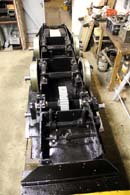
December 2013
The work on the L180 no. 1361 continues
unabated. In connection with the mounting of the axles and the
jackshaft all bearings have been replaced, which involves considerable
complexity. Of course, the oil grooves were milled again into
the cups. Also the exhaust box has returned to its place in the
locomotive frame. Next, the rods follow. 




November 2013
Now the small M00A no. 126 has
repaired hood parts and a newly built rear panel. The repair of
the hood by a locksmith certainly needed more work than a new
construction, because it was so battered and partly cutted. But
so the original substance could be almost completely preserved.
And a few small bumps are usual at a Decauville loco. Now even
the frame and chassis must be repaired. Engine and transmission
are already in process in parallel.



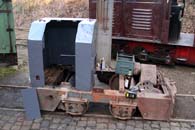
October 2013
The Norwegian handcar unfortunately
had the lack, that its third wheel was missing, because it wasn't
to find in the scrap heap at Notodden station. With to the help
of Thor Bjerke of the Norwegian Railway Museum in Hamar a matching
wheel found its way to Germany. It has been restored, completed
with two new steel rings - coloured "Norway brown" -
and mounted on the handcar. The vehicle is likely the only one
known on 600mm gauge. The slopes in Glossen provide quite a sporting
challenge for the " rider".
September 2013
The reconstruction of the Montania
L180 is going on slowly but steadily. In March, both axes
were electro-surfaced and reprofiled by the MaLoWa in Benndorf
. The bad condition of the first axle - caused by eroding mine
water - made it necessary. As part of this work also all bearing
surfaces have been repaired, the crankshaft journals too. Because
of the new bearing measurements , all bearing shells had to be
re-manufactured, the jackshaft included. Additional the metal
panels, subsequently welded in to the buffers, have been removed
and hardwood chunks were fitted. This buffer construction was
used only until the twenties. 





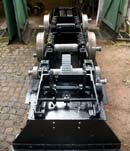


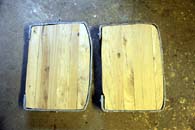
The axes of the mining RL1c had to be reconstructed
because the transformed to double flenged wheels during its last
use in a clay pit. See also the photo of a year ago. During the
the dismounting it was evident that the bush bearing had been
converted to roller bearings added with new housings. But both
of them were useable bacause of the intensive waste and had to
be replaced. Now it was time to lift the locomotive from its flat
car and to set it on its own " feet ", of course with
new springs.




May 2013
Sometimes unbelievable things happen.
For example, that in the year 2013 a Jung loco still stands in
a private garden since almost 50 years. Once, in it's second life,
it was used as a drive of a circular saw. But not long until an
engine failure finished this service. The rest of the time until
today it remains in a kind of twilight sleep without gear. It
wasn't necessary for the saw use. But a replacement gearbox from
a decades ago scrapped loco is waiting for duty in the store.
The recovery of the EL105 No. 8002 was not easy to do because
it had been brought down to its place with the help of a long
steel cable from a mountainside. Now it was to bring back up this
slope without a rope but with a wheel loader. Despite other expectations
there was no problem. The dismounted spring buffer of the back
of the loco was found buried in the soil next to a nearby tree
and in the open tank filler neck funnel-shaped mushrooms had taken
root, reminiscent of a "Yes" album cover. Inspite of
the extended length of outdoor time the locomotive is in a surprisingly
good overall condition.







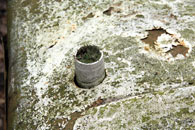
February 2013
After remaining the M00A in the
locomotive shed for some time, it would make sense to repair the
metal sheets as a first step on the way to further reconstruction.
So an inventory and the dismantling of the remaining remnants
of the bonnet happened. The motor-gear block looks a little bit
like the construction of O&K type M, the exterior like the
MD series with their weight hangings on the frame. The origin
of the construction of the Montania locos is apparently. The M00A
rightly has its unique name, it is obviously the little sister
of the MD1 or MV0. May be there was no market in Germany for such
a lightweight loco. For smaller companies in Spain it was apparently
sufficient, that also shows the number of surviving machines.






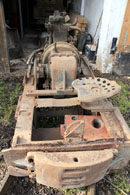
January 2013
For fitting again the chassis of the L180
in spring, all other frame connected parts have to be refurbished.
Axle boxes and springs have been sand-blasted and repainted. The
springs are in good condition, only the upper layer of one of
them needs to be replaced because it's broken and "Feldbahn
like" repaired with a rail joint. A special detection after
the sand-blasting were stamps of the manufacturer "D &
N" (a today unknown company), as well as of the year 1920.
So it can be sure considered, that the 1361 really was built and
delivered to Norway in this year and there was no delay because
of the First World War.



